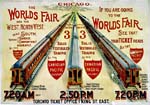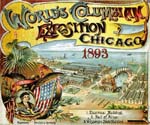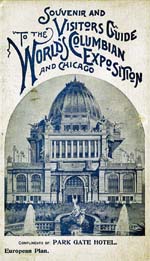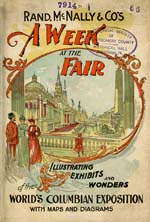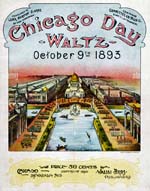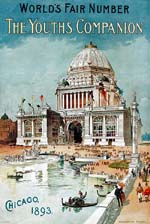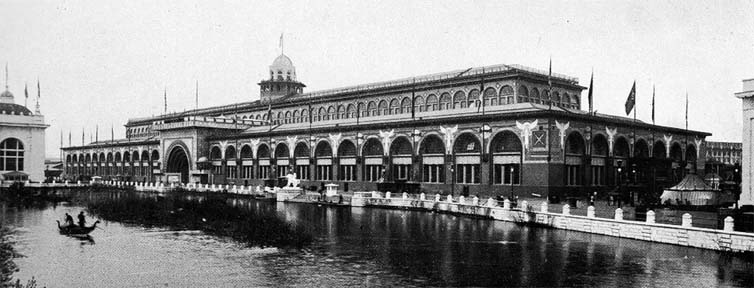 |  Bibliography |
A Photographic Record
1980
Dover Publications.
Paperback.
128 pages, 8.25 x 11 inches, $16.95 Amazon.
Originally conceived to commemorate the 400th anniversary of Columbus's discovery of America, the World's Columbian Exposition of 1893 was one of the largest (633 acres) and most influential aggregations of human talent, energy, and industry ever assembled. More than 27 million visitors entered the grounds (now Jackson Park) to marvel at the exhibits and displays housed in some 200 buildings, including those of 79 foreign governments and 38 states. Although the Fair had its share of firsts (original Ferris wheel, first midway, Edison's kinetoscope, etc.), its chief marvel was its architecture. It is that aspect which is emphasized in this striking photographic record. Beginning with an overview of the fair's planning and conceptual stages, Stanley Appelbaum's well-researched text then proceeds to a fascinating discussion of the personalities, regional rivalries, and intense controversy surrounding the Beaux-Arts architecture (the "White City" style) of the fair, including its enormous impact on subsequent American architecture. The contributions of such outstanding architects and firms as R.M. Hunt, McKim Mead and White, Frederick Law Olmsted, and Peabody and Stearns are described. The book then becomes a building-by-building walking tour of the fair, imaginatively reconstructed with the help of 128 sharply reproduced rare contemporary photographs, printed on fine coated stock, and a concise, fact-filled, text. The placid basins, ponds, and lagoon that graced the fairgrounds lend a serene aura to these priceless views of the great buildings and sights of the fair. The Beaux-Arts glories of the Administration and Agriculture Buildings, Daniel Chester French's statue of the Republic, the Columbian Fountain by Frederick MacMonnies, the Golden Door of Louis Sullivan's Transportation Building, the Peristyle, Mary Cassatt's mural in the Woman's Building, the pure classicism of the Palace of Fine Arts (now the Museum of Science and Industry), numerous state and foreign pavilions, and of course, the Midway, the first separate amusement area at a World's Fair, and the reputed location of Little Egypt's celebrated danse du ventre. In the concluding section, the author touches on other memorable aspects of the fair and its times, the Panic of 1893, the Pullman Strike, famous visitors Archduke Ferdinand, the Spanish Infanta, etc., cultural and social congresses, and finally, the disastrous fires that ultimately destroyed many of the buildings. For social and cultural historians, Chicagoans, and anyone interested in the special magic of a world's fair, this book is a loving and nostalgic look back, to a time bathed in the golden light of the fin-de-siecle years, when a colossal spectacle of human achievement in art, science, and industry captured the world's attention for one magic and unforgettable moment.
The Chicago World's Fair of 1893
2002
University of Illinois Press.
Paperback
176 pages, 21.59 x 27.94 centimetres, $30.45 Amazon.
This exceptional chronicle takes readers on a visual tour of the glittering "white city" that emerged along the swampy south shore of Lake Michigan as a symbol of Chicago's rebirth and pride twenty-two years after the Great Fire. The World's Columbian Exposition, which commemorated the 400th anniversary of Columbus's voyage to America, was held from April to October in 1893. The monumental event welcomed twenty-eight million visitors, covered six hundred acres of land, boasted dozens of architectural wonders, and was home to some sixty-five thousand exhibits from all over the world. From far and wide, people came to experience the splendors of the fair, to witness the magic sparkle of electric lights, or ride the world's first Ferris wheel, known as the Eiffel Tower of Chicago. Norman Bolotin and Christine Laing have assembled a dazzling photographic history of the fair. Here are panoramic views of the concourse, replete with waterways and gondolas, the amazing moving sidewalk, masterful landscaping, and horticultural splendors, and reproductions of ads, flyers, souvenirs, and keepsakes. Here too are the grand structures erected solely for the fair, from the golden doorway of the Transportation Building to the aquariums and ponds of the Fisheries Building, as well as details such as menu prices, the cost to rent a Kodak camera, and injury and arrest reports from the Columbian Guard. This unique volume tells the story of the World's Columbian Exposition from its conception and construction to the scientific, architectural, and cultural legacies it left behind, inviting readers to imagine what it would have been like to spend a week at the fair.
(Images of America)
2012
Arcadia Publishing.
Paperback.
128 pages, 6.5 x 9.25 inches, $22.79 Amazon.
What came to be known as the World's Columbian Exposition was planned to commemorate the 400th anniversary of Christopher Columbus's 1492 landfall in the New World. Chicago beat out New York City, St. Louis, Missouri, and Washington, DC, in its bid as host, a coup for the Windy City. The site finally selected for the fair was Jackson Park, a marshy area covered with dense, wild, vegetation. Daniel H. Burnham and John W. Root were selected as chief architects, creating the famous White City. The fair featured several different thematic areas, the Great Buildings, Foreign Buildings, State Buildings, and the Midway Plaisance, a nearly mile-long area that featured exotic exhibits. The exposition also showcased the world's first Ferris Wheel and introduced fairgoers to new sensations like Cracker Jack, Pabst Beer, and ragtime music. Unfortunately, by 1896, most of the fair's buildings had been removed or destroyed, but this collection takes readers on a tour of the grounds as they looked in 1893.





